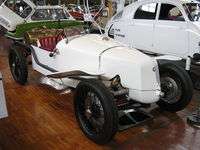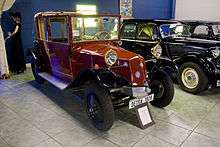Tatra 12
| Tatra 12 | |
|---|---|
|
| |
| Overview | |
| Manufacturer | Tatra |
| Production |
|
| Assembly | Kopřivnice, Moravia, Czechoslovakia |
| Body and chassis | |
| Class | Mid-size car |
| Body style | See picture |
| Layout | FR layout |
| Powertrain | |
| Engine | 1,057 cc (1.1 L) Tatra 11 F2 |
| Transmission | 4-speed manual |
| Dimensions | |
| Wheelbase | 2,646 mm (104.2 in) |
| Curb weight | 680–900 kg (1,500–1,980 lb) |
| Chronology | |
| Predecessor | Tatra 11 |
| Successor | Tatra 57 |
Tatra 12 is a model of vintage automobile made by Czech manufacturer Tatra. It was manufactured between 1923 and 1926. It was replaced by the Tatra 57 in 1932.
All Czech car manufacturers were making large and expensive cars at the beginning of the 1920s, which only the rich could afford. Some companies tried to introduce an inexpensive design, which would be affordable for the middle class. Tatra's solution to this was the Tatra 11 of which the Tatra 12 is successor.
Design
Hans Ledwinka, Tatra's designer, came up with a revolutionary idea of a backbone tube chassis, which he introduced on Tatra 11. Tatra 12 follows the same principles with the backbone tube, which has mounted the differential with swing half-axles at the rear. The gearbox has 4 speeds (+reverse) and the engine is on the top of it, while both are mounted on the front of the backbone tube.
The engine is a petrol flat two cylinder which is cooled by onslaught air. Thanks to this the expensive and heavy radiators could be avoided - this was an excellent idea at the time, when antifreeze was rather problematic.
The front axle has suspension by transverse leaf springs. While Tatra 11 had drum brakes only on the rear wheels, Tatra 12 had drum brakes all around.[1]
The two-door four seat saloon had as the front seats nickel and later chrome plated cantilever tubular steel seats with folding backrests installed that inspired Mart Stam to design his own cantilever chair.[2]
Versions

The chassis itself weighs around 500 kg (1,100 lb). There were many different bodies built on it (see picture). The chassis itself was also sold to other manufacturers to build their own car bodies on it.[1]
Weymann motor body
Most car bodies of the era were built by nailing metal plates on the wooden skeleton of the car. The wood was usually very rigid, often the ash-tree was used. This made the body very firm, but rather heavy.
Weymann's system was different. The wooden pieces were not mortised together, but only loosely put next to each other. The wooden pieces were merely touching each other and its ends were coated in a buffer material (often leather). The wooden pieces were joined together via steel strips. This type of bodywork wasn't totally firm, but it allowed natural shifts which occur as the wood gets dry or wet. Such shifts made it impossible for use of metal sheets, therefore the exterior was covered in artificial leather.[1]
Targa Florio
The Targa Florio version was quite different from the serial production models. The engine and the bodywork were changed the most, but also the chassis was altered by changing the front axle.
The cylinders were made from a special alloy, which allowed it to work even under extreme heat. The modified engine had about 30 hp (22 kW) at 5000 rpm (the standard version had about half). The car had also the tachometer, unlike the production version. The front axle was similar to the one of Tatra 17 with swinging half axles (standard version had half axles only at the rear, while front was solid).
The bodywork itself was built in a manner similar to the aeroplane design of the era - from plywood; only the front bonnet was made from aluminium plate. This made the body weigh only around 25 kg (55 lb), while the whole car weighed 560 kg (1,230 lb).
The car was able to reach speeds up to 120 km/h (75 mph) (almost twice of the standard version) and it therefore needed better brakes. To allow easier re-fuelling the fuel tank with capacity of 60 L (16 US gal) was placed behind the rear seats. To its advantage Tatra 12 didn't need stops for change of coolant (as the engine was air-cooled). The factory made the cars with mud-guards, however they were usually stripped for a race.
The Targa Florio cars took part in many races, i.e. in Stuttgart, Ecce Homo, or the Great Russian contest of reliability. In 1925 debuting Tatra 12s took part in the Sicilian Targa Florio race, after which the race models were later named. The two cars driven by Fritz Huckel and Karel Sponer took both first and second position in the category of under 1100 cc. Huckel had beaten the track record by 26 minutes and Sponer had beaten it by 21 minutes.[3]
Normandie
The Normandie car bodies were following the popular and highly used cars in France. The cheaper version was often used as a utility car.
Other versions
There were many other versions built both by Tatra itself, or other manufacturers who were building their own car bodies on top of the Tatra 12 chassis.
|
|
|
Tatra 12 Sport |
 1928 Detra - a rebranded Tatra 12 assembled in Germany |
|
Tatra 12 Van |
Tatra 12 Pickup |
 Tatra 12 Firefighting car |
References
- 1 2 3 "Tatra 11, 12, 13". eurooldtimers.com. Retrieved 2010-06-09.
- ↑ Ivan Margolius, 'Cars, Furniture, Architecture', The Automobile, April 2016, pp.54-58
- ↑ "Tatra 12 Targa Florio". veterantatra.com. Retrieved 2010-06-09.
External links
- Tatra 12 technical data on Tatraportal.sk
- Video of Tatra 12 Targa Florio Replica
- Tatra 12 in 1960's anti-alcohol-driving propagation movie
| Wikimedia Commons has media related to Tatra 12. |